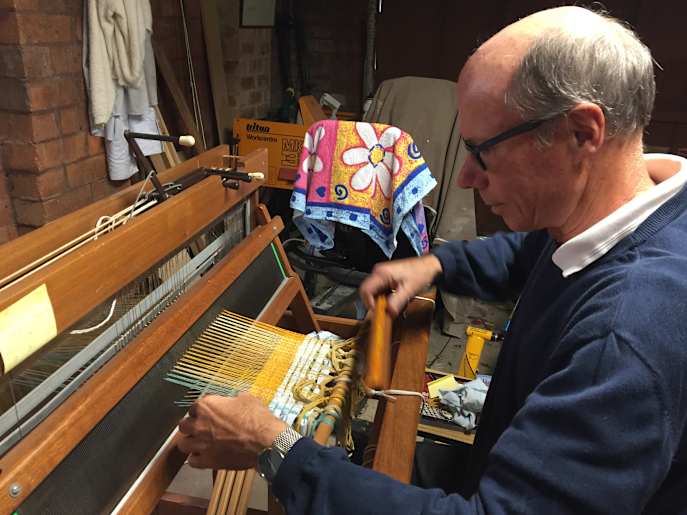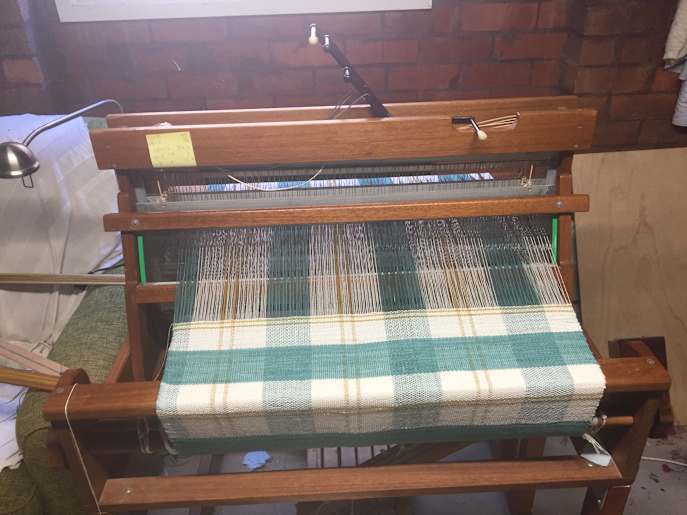Janice Creenaune meets Carl Murphy, who worked as a public servant in Canberra, before retiring to Austinmer in 2018 and re-engaging with a past passion in spinning and weaving while breaking gender expectations in the process.
When viewing Carl Murphy’s weavings you are immediately taken by the intricacy of design, the colours chosen and the dedication to perfection, in creating a beautiful woven scarf or table runner. These are works of art created in a time-intensive traditional craft.
Carl first began weaving at the age of 16.
“My mother was a spinner and weaver, she was my first and most wonderful teacher," Carl says. "I was always interested in fibre arts and textiles and I was fortunate enough to attend an International School, Pearson College, on Vancouver Island, Canada, from 16-18 [years of age], completing the International Baccalaureate, and I did a course in spinning and weaving.
"I had a marvellous teacher in Cheryl Samuel, who has written a number of fine books on the art of spinning and weaving, and I kept up the skills for a period. However, work and life commitments soon got in the way, having no equipment and little time limits the pleasure for the craft.
“When I retired, however, I knew I wanted to come back to what I had always really enjoyed, spinning and weaving. I now had the time, the patience and the space to enjoy it. Moving to Austinmer enabled a great opportunity to re-engage. When I joined The Wollongong Handweavers and Spinners Group I realised I had found the like-minded with a similar passion.
"We meet every Monday during school term at Mt Ousley Public School and once a month we have a Show and Tell. We also have about 12 looms and spinning wheels running at the centre and it is amazing what members produce. We definitely learn from each other, as well as the general camaraderie and friendships that develop.”
The Wollongong Handweavers and Spinners Group began in 1961 and Carl is the first male member of the group.
“I guess I am a bit of an oddity,” Carl says, “but now I am just part of the group and we learn from each other, hold exhibitions and share resources. We become each other’s brains trust and we exist as our own community each week. We also hold an annual exhibition in Fairy Meadow.”
The fibre arts involve the intricacies of different materials, spinning wool, silks or other natural materials, using natural dyes and commercially produced products.
“I enjoy the whole array of skills, but I particularly enjoy dealing with the natural processes, natural fibres and dying with natural colours. Onions skins, for example, provide a rich and glossy brown/golden colouration and there are many flowers that also can be used for different effects.”
Carl says dyeing with natural products can be frustrating. “It can be hit and miss with objectives and outcomes, but it can also be very exciting when the dyeing process creates something unexpectedly beautiful.”
Spinning the fleece is a work of art in itself. “Removal of burrs and other impurities is important and it is a real challenge to create perfection in the yarn. Strength is particularly essential in the warp of the weave where the warp acts as the backbone to the work on the loom and is stretched particularly tight. The weft is a little more lenient and allows a little more texture and tactile awareness.
“Weaving is definitely both an art and a craft. Designing a piece is the art, the ‘doing’ is the craft. Sometimes I follow a pattern, other times I design my own. It can be very mathematical as well as repetitive. I must have enough materials before the project begins. A focus on choice of colours, patterns and texture are all important.”
Carl says the best works tend to focus on two of these elements and that his wife, Kathy, has strong influences on his colour choice. “It is most often that she will wear my projects at the conclusion, so that makes her input doubly important.”
Setting up the loom takes time and patience, with little opportunity to change an idea once the warp is ready. “You just have to persevere with the project. That is why it is so important to be patient and have a well-thought out project, patience in setting up the loom, all before any weaving actually starts,” Carl says. Each project can take about 40 hours but with a more intricate design it can take between 60 and 80 hours. “My labour costs can never really be factored in, covering costs of materials though is important. I could never make a living from the craft. It is just not profitable enough ”
Carl says he finds weaving relaxing. “It does, however, depend on the project. If a complicated pattern I listen to music. If not so detailed I can tune into a podcast,” he says, “but it is definitely an intellectually demanding craft. It is also peaceful and relaxing when it is repetitive (but never mindless) and it absorbs you completely as the project grows.” Carl says that occasionally the project can be very surprising and that joy of discovery is very exciting. “I always have to be in the moment, though, when weaving, as there is no room for errors.”
The Wollongong Handweavers and Spinning Group is planning to offer opportunities to teach those interested in the crafts. “All beginners really need is the time and patience to work at the skills and practice over about four to five sessions. With costs, we are just looking at covering materials. Our expertise will not even be factored in.”
Carl Murphy has proven his dedication and passion for the crafts of spinning and hand-weaving. Together, with the group, he continues to inspire others and demystify these traditional arts.
For further information please contact wollongongspinnersandweavers@gmail.com
Janice Creenaune is a volunteer for PKD (Polycystic Kidney Disease) Foundation Australia. Email janicecreenaune@gmail.com for further information.

















